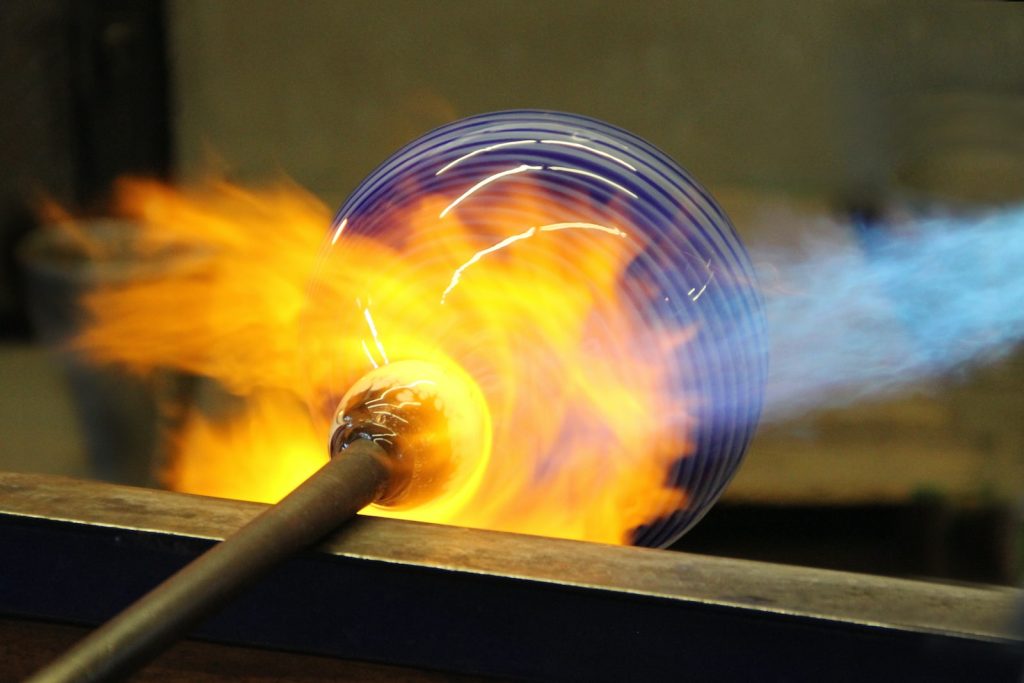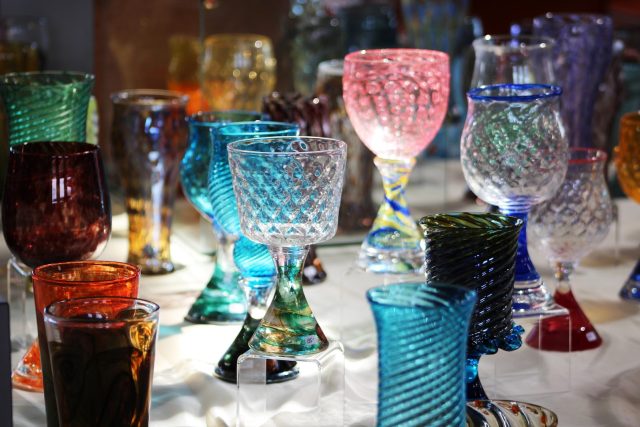Glassblowing is an ancient art form used to create various stunning works of art in many cultures throughout history. It is a mesmerizing process involving the manipulation of molten glass through a series of intricate techniques. Although glassblowing has primarily been used for decorative purposes, it can also be used to make functional items such as cups, vases, and bottles.
Glassblowing for Art
Glassblowing is an ancient art form that has existed for thousands of years. It involves using a blowpipe to shape molten glass into various shapes and forms, which can then be used for functional or decorative purposes. Today, glassblowing is a popular art form, with many artists creating intricate and stunning pieces of art.
One of the unique aspects of glassblowing is that the glass is always in a fluid state, which means that the artist has a limited amount of time to shape it before it cools and hardens. This requires great skill and precision, as even a small mistake can ruin the entire piece.
Glassblowing is a versatile medium, and artists can use a variety of techniques to create different effects and textures in their work. Some artists use colored glass, while others incorporate other materials such as metals or wood.
Whether you are a collector or appreciate the beauty of glass art, glassblowing is a fascinating art form that offers endless possibilities for creativity and self-expression. And by watching a glassblower at work, you can gain a deeper appreciation for the skill and precision that goes into creating these stunning art pieces.
History of Glassblowing
Glassblowing has a long and rich history, dating back to the first century BC in the Roman Empire. The technique was developed by Syrian craftsmen who discovered that blowing through a hollow pipe could shape molten glass into various forms. The Roman Empire was known for its glassblowing, and the technique spread throughout the empire, with many craftsmen perfecting the art and developing new techniques.
In the Middle Ages, glassblowing became a popular craft in Venice, where glassmakers developed the famous Venetian glass, which was highly prized for its color and clarity. The glassblowers of Venice became some of the most skilled in the world, and their works of art were highly sought after by European collectors.
In the 19th century, glassblowing became more mechanized, and many of the traditional techniques were replaced by machines. However, in the 20th century, there was a resurgence of interest in traditional glassblowing techniques, and many artists began to explore new ways of using the medium to create stunning works of art.
Glassblowing is a popular art form today, with artists worldwide using the technique to create intricate and stunning art pieces. It is also used for functional purposes, such as creating laboratory glassware and glass bottles. Despite the many changes in technology and techniques over the years, the basic process of glassblowing has remained the same. The art form continues to be celebrated for its beauty and precision.
Process of Glassblowing

Glassblowing is a fascinating process that involves several steps, starting with melting the raw materials that will become the glass. The most common raw materials used in glassblowing are silica, soda ash, and limestone. Once the raw materials are heated to a high temperature, they melt together to form a liquid glass mixture.
The glassblower then uses a long metal tube called a blowpipe to gather a small amount of the molten glass from the furnace. The glass is shaped by blowing air into the pipe and manipulating it as it cools and hardens. To achieve different shapes and forms, the glassblower may use a variety of tools, such as molds, shears, and paddles.
The glass can also be colored by adding various pigments to the molten glass. Different colors can be achieved by adding different combinations of pigments, and the glassblower can use these colors to create intricate patterns and designs in the glass.
Once the glass has been shaped and cooled, it is placed in an annealing oven to cool and stabilize slowly. This process ensures that the glass does not crack or shatter due to stress caused by temperature changes.
Glassblowing is a delicate and precise art form that requires a great deal of skill and practice. Every piece is unique, with its own distinct patterns, colors, and shapes, making it a fascinating and endlessly varied medium for artists to work with.
Tools and Techniques
Glassblowing is a delicate and intricate art form that requires skill and precision to create intricate glass objects. It involves manipulating molten glass by blowing air into a tube, shaping it using specialized tools, and cooling it down to its final form.
Tools:
- Blowpipe: A long hollow tube made of steel or stainless steel to gather the molten glass from the furnace. It is also used to blow air into the molten glass to create bubbles and shape it into the desired form.
- Marver: A flat steel or graphite table used to shape the molten glass by rolling and flattening it.
- Punti: A solid rod used to hold the glass object while it’s being worked on.
- Tweezers: Used to shape and pull the molten glass to create intricate patterns.
- Jacks: Large pliers used to shape and create the neck of the glass object.
- Shears: are used to cut and shape the glass when it is hot.
- Molds: Used to shape the molten glass into specific forms.
- Ladles: Used to pour the molten glass into molds or other containers.
Techniques:
- Gathering: Dipping the blowpipe into the furnace and collecting molten glass.
- Shaping: Once the glass is gathered, it is placed on the marver to shape it into the desired form using the abovementioned tools.
- Blowing: The process of blowing air into the blowpipe, which is then directed into the molten glass to create bubbles and shape them into the desired form.
- Annealing: The process of slowly cooling the glass object to room temperature to prevent it from shattering or cracking. This is done in a special oven called a kiln.
- Cutting and polishing: Once the glass has been annealed, it is often cut and polished using various tools to give it a smooth and finished appearance.
- Engraving: A technique used to etch designs or patterns onto the surface of the glass object using specialized tools.
Glassblowing is an intricate and fascinating art form that requires skill and precision to create beautiful and unique glass objects. With the right tools and techniques, anyone can learn to create their own stunning pieces of glass art.
Types of Artwork Produced
Glassblowing is an art form that allows for a wide range of creativity and expression, producing many different types of artwork. Here are some of the most popular types of artwork produced through glassblowing:
- Vases: The vase is one of the most popular types of glassblowing artwork. Vases can be created in a wide range of shapes, sizes, and colors. They can be simple or intricate and are often used for floral arrangements or as decorative pieces in their own right.
- Sculptures: Glass sculptures are another popular type of artwork produced through glassblowing. These sculptures can range from abstract shapes to realistic depictions of people or animals. The transparency and reflective qualities of glass make it an ideal medium for creating delicate and intricate sculptures.
- Bowls: Glassblowing bowls can come in a variety of shapes and sizes. They can be simple or complex, with intricate designs etched into the surface. Glass bowls can serve as decorative pieces.
- Paperweights: Glassblowing paperweights are often small but can be incredibly detailed and intricate. They can be made in various shapes and sizes, with designs ranging from simple to complex.
- Drinkware: Glassblowing also creates drinkware such as glasses, goblets, and tumblers. These pieces can be simple or elaborate, often used for special occasions or as part of a larger tableware set.
- Chandeliers: Glassblowing can also create large-scale pieces such as chandeliers. These pieces are often intricate and require a high skill level to produce.
- Jewelry: Glassblowing can create unique and beautiful jewelry pieces, including pendants, earrings, and bracelets. Glass can be combined with other materials, such as metal or beads, to create one-of-a-kind pieces.
In conclusion, glassblowing is a versatile and creative art form that can produce many beautiful and unique pieces. Glassblowing offers endless possibilities for artistic expression, from vases and sculptures to paperweights and jewelry.
Benefits of Learning Glassblowing
Learning glassblowing can be an incredibly rewarding experience. Whether you are looking to pursue it as a hobby or a career, there are numerous benefits to learning this art form.
One of the most significant benefits of learning glassblowing is the opportunity to express your creativity. Glassblowing is a highly creative art form that allows for endless possibilities. It offers a unique way to express your ideas and bring them to life. Glassblowing provides an opportunity to use color, shape, and texture to create one-of-a-kind pieces that reflect your individual style.
Glassblowing also provides a chance to learn new skills. Working with molten glass requires focus, precision, and patience. Glassblowing classes often provide a structured environment where students can learn the necessary techniques in a supportive and collaborative setting. Learning glassblowing is not just about creating beautiful pieces; it also involves problem-solving and critical thinking, which can be valuable skills in other areas of life.
Another benefit of learning glassblowing is the opportunity to be part of a community of artists. Glassblowing classes and studios often provide a supportive environment where students can learn from each other and work together. The glassblowing community is diverse and inclusive, with people from all walks of life coming together to share their passion for this art form.
Learning glassblowing can also be a therapeutic experience. Working with hot glass requires a high level of concentration, which can help clear the mind and reduce stress. The process of creating something beautiful with your own hands can also provide a sense of accomplishment and fulfillment.
Finally, glassblowing can be a rewarding career path. Glassblowers can work in a variety of settings, from small studios to large production facilities. They can also specialize in various types of glassblowing, such as scientific glassblowing or art glassblowing. Pursuing a career in glassblowing can provide opportunities for creativity, job security, and financial stability.
Learning glassblowing offers numerous benefits. Including the opportunity to express your creativity, learn new skills, be part of a community, experience therapeutic benefits, and pursue a rewarding career.
Conclusion
In conclusion, glassblowing is a timeless art form with a long and varied history. It has been used to create intricate works of art, functional tools, and everyday objects that have been enjoyed by people across the world for centuries. The process of glassblowing involves manipulating molten glass using specialized tools while keeping up with techniques that have evolved over time.
It may take years of practice to perfect and requires an understanding of color mixing, heat application, and shaping techniques before you can truly master the craft. For those who are willing to put in the effort, there are many rewards in store. From creating beautiful sculptures to making useful items like drinking glasses or jewelry boxes. Glassblowing is an amazing skill that can be learned by anybody who has the ambition and dedication to learn it!






























